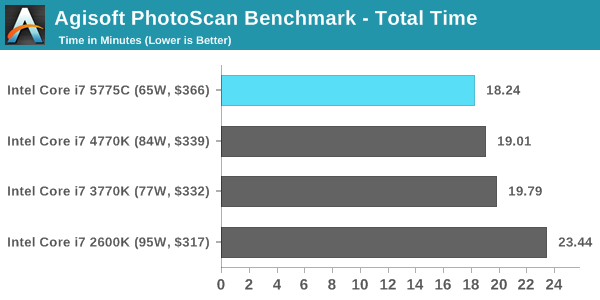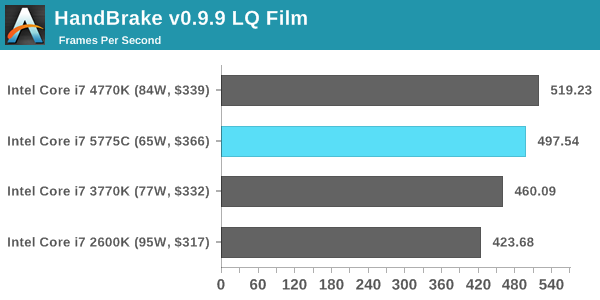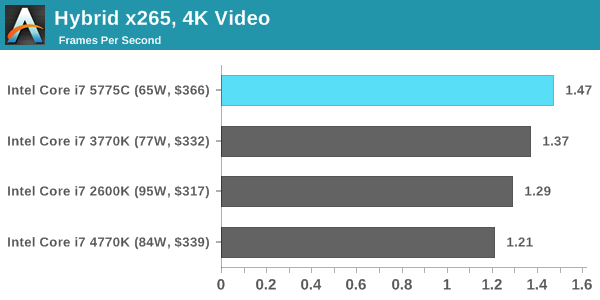The Intel Broadwell Review Part 2: Overclocking, IPC and Generational Analysis
by Ian Cutress on August 3, 2015 8:00 AM ESTProfessional Performance: Windows
Agisoft Photoscan – 2D to 3D Image Manipulation: link
Agisoft Photoscan creates 3D models from 2D images, a process which is very computationally expensive. The algorithm is split into four distinct phases, and different phases of the model reconstruction require either fast memory, fast IPC, more cores, or even OpenCL compute devices to hand. Agisoft supplied us with a special version of the software to script the process, where we take 50 images of a stately home and convert it into a medium quality model. This benchmark typically takes around 15-20 minutes on a high end PC on the CPU alone, with GPUs reducing the time.

Cinebench R15
Cinebench is a benchmark based around Cinema 4D, and is fairly well known among enthusiasts for stressing the CPU for a provided workload. Results are given as a score, where higher is better.


HandBrake v0.9.9: link
For HandBrake, we take two videos (a 2h20 640x266 DVD rip and a 10min double UHD 3840x4320 animation short) and convert them to x264 format in an MP4 container. Results are given in terms of the frames per second processed, and HandBrake uses as many threads as possible.


Hybrid x265
Hybrid is a new benchmark, where we take a 4K 1500 frame video and convert it into an x265 format without audio. Results are given in frames per second.











121 Comments
View All Comments
TheinsanegamerN - Monday, August 3, 2015 - link
Quite nice comparison.Unfortunately, it seems that, while broadwell does have the best IPC of the bunch, the overclock is pathetic. 1.325v to hit 4.2 GHz? my ivy bridge 3570k does the same clock with 1.075v. now, I've been told I have a exceptionally good chip, but it strikes me as odd that broadwell, being on a smaller 14nm process, cant match what ivy bridge could do two years ago. and since sandy bridge can be OC'ed to 4.7GHz+ with ease,and ive can hit 4.5, it seems there is still no reason to upgrade to broadwell, as any IPC gains are cancelled out by the lower clock rate. unless you need to do lots of dolphin emulation and refuse to overclock at all, the ancient sandy bridge still seems to do the best.
K_Space - Monday, August 3, 2015 - link
TheinsanegamerN agreed. Those who held into their Sandy made a very wise investment, just like those good ol' 920s back in the X58 era.Dupl3xxx - Monday, August 3, 2015 - link
Ah, yes, the 920 was a lovely beast. Started overclocking at 3.6. It booted, tried 3.8, booted, tried 4.0, failed. 3.8 was literally done in less than an hour as my second ever attempt at overclocking, with my first being the intel e6600. And when a dying PSU wounded it, I got a 3930k. It does 4.0 ghz, and I've yet to find any situation where it's a bottleneck, besides things like rendering and benchmarks. I considered upgrading to the 59xx series, but when I learned that only the 5960x would be a 8-core, that was quickly decided against.It'll be interesting to watch Skylake and Zen fight it out in a year or so.
Impulses - Monday, August 3, 2015 - link
I'm surprised Intel isn't banking on nostalgic memories of the Q6600 to hype the 6600K & 6700K... Surely marketing had a hand in the simplified naming reminiscent of the old C2Q.augiem - Monday, August 3, 2015 - link
I'm still on a i7-920 from mid 2009. Been running 3.6GHz the entire time, still rock solid as the day I bought it. I still can't believe I've been using a PC for this long. Before the i7, I would upgrade every 1.5 - 2 years tops. This thing is nuts.mkozakewich - Tuesday, August 4, 2015 - link
We've reached the end of that exponential advancement, so you can expect things to advance at roughly this rate for a while, at least until we also reach "small enough".close - Tuesday, August 4, 2015 - link
That's logarithmic advancement :). It keeps slowing down year after year.Cryio - Tuesday, August 4, 2015 - link
Technically with Sandy Bridge they reached the end. SB was quite a jump over Nehalem.Harry Lloyd - Tuesday, August 4, 2015 - link
There is no end. Intel just do not care, as they have no competition. Why would they waste money on increasing performance, when they can focus on efficiency for mobile? They can get away with selling basically the same CPUs every year on desktop, as they are still the fastest.Badelhas - Tuesday, August 4, 2015 - link
I also blame AMD. If they had good high end CPUs Intel would be forced to improve the ones they´ve been selling for the last 5 years or so.